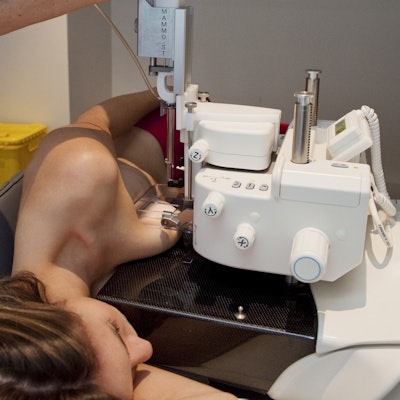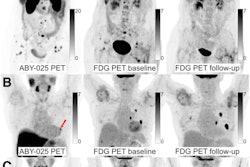
Retained image-guided breast biopsy site markers tied to index malignancy should be considered suspicious for residual malignancy, suggest findings published August 30 in the American Journal of Roentgenology.
Researchers led by Eun Langman, MD, from Duke University Medical Center in Durham, NC, found that initial postoperative mammography is not enough to exclude malignancy based on these site markers.
"In this scenario, timely additional tissue sampling targeting the retained biopsy site markers is warranted, given [the greater than] 2% chance of malignancy," Langman and colleagues wrote.
While biopsy site markers found on image-guided breast biopsy are typically removed or disappear after surgical excision, initial postoperative mammography after such removal occasionally shows retained markers in less common cases. These findings raise concern that the target breast lesion was not entirely removed, meaning that the patient could still have residual malignancy.
However, the researchers noted that there is little data available on further guiding management in this scenario.
Langman and colleagues sought to evaluate the frequency of residual malignancy in women with retained biopsy site markers identified on initial mammography after breast lesions are surgically removed.
The researchers included data from 30 women. Of these, 13 specimen mammograms were interpreted intraoperatively by the surgeon with later interpretation by the radiologist. The remaining 17 underwent real-time radiologist interpretation. In addition, 18 of the women had malignant index pathology from the initially resected lesion.
On follow-up after surgical resection, the team found that a higher frequency of residual malignancy in women with malignant index pathology at 39% (7 of 18) compared with the 0% (0 of 12) seen in those with nonmalignant index pathology (p = 0.02).
The group also found that among women with a malignant index pathology, the frequency of residual malignancy was higher in women without malignancy in the initial surgical specimen at 80% (4 of 5). For women with malignancy, this was 23% (3 of 13; p = 0.047).
Finally, the researchers found no significant differences between women with (57%) and without residual malignancy (54%) when it came to the frequency of a positive interpretation of the initial postoperative mammogram at a higher BI-RADS category (p > 0.99).
The study authors suggested that, based on their results, interpreting radiologists should recommend diagnostic mammography for finding retained biopsy site markers in women with malignant index pathology and a missing biopsy site marker on specimen radiographs.
"A two- to four-week interval after surgery may be appropriate for these early postoperative mammograms; in the present study, the median time to the early post-operative mammograms was 23 days," they wrote.
The authors also recommended active surveillance is a management strategy in women with retained biopsy site markers from nonmalignant index lesions.
The study can be found in its entirety here.




















